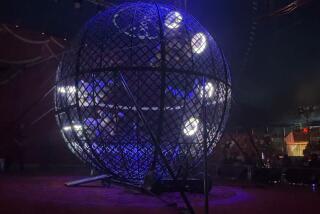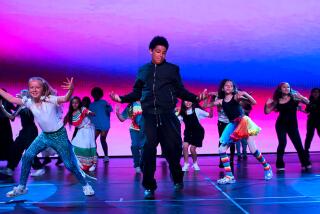A Las Vegas education in the three-ring arts
- Share via
This city may seem like a circus in its own right, but to performers who specialize in impossible contortions and riding silk ropes while defying gravity, Las Vegas is the epicenter of reckless courage and derring-do.
And on any given day, a number of Cirque du Soleil performers and circus-act divas can be found testing the trampoline, inching along padded bars, jumping through hoops while juggling a riot of plates swinging from the ceiling and balancing on colorful cascading cloths at Sandou Theatrical Circus School, an unassuming warehouse structure rising amid chaparral outside the city.
Six days a week, trainers bark encouragements as performers dip and strain. The facility, open to the public, is the only place in Las Vegas to train for these feats besides the stage and commercial athletic gyms. Because this is the first and only school for the circus arts in town and one of the few in the U.S., the ropes, the rings, the wires and swings are in use most of the time. But the mornings at Sandou belong to the kids.
Behind a slew of warehouses west of Interstate 15, the Sandou school swings into action at 9 a.m. Out come the juggling balls, the sticks and plates, the balancing balls, the mats and vaulting boards, the balancing bars and the silken drapes and swaying bars that hang from heights of 30 feet in this 7,000-square-foot, three-ring playground. And in come the kids of all shapes and sizes to learn the ropes. Almost no child is too young or too small for the circus.
Making it all happen are two Moldovan masters, the brothers Sandou -- Sergei and Konstantin, who spent their youth in circus camps in Moldova and with the Moscow State Circus before joining Ringling Bros. and Barnum & Bailey in the United States. Sergei’s wife, Augustina Badea-Sandou, a former member of the Romanian Olympic gymnastic team, helps out with the kids, teaching them to spin the ball beneath their feet and wiping away their tears of fear.
“Who’s going to run the circus?” Sergei asks. “These kids are going to be the next generation of performers.”
He takes out some orange balls to show the children how to juggle. They grab some, hold them, throw them, pick them up and throw them again. Meanwhile, Sergei juggles effortlessly, sending the balls circling even as he focuses on the kids and explains the exercise.
Fighting a losing battle for their interest, he switches to sticks and plastic plates, and suddenly the room is a-twirl in revolving discs. Confidence renewed, the kids move to balancing on balls. One by one, they hop up and find their balance and begin to walk on the ball with a little grace and a lot of hesitation. One boy cries and refuses to do the exercise. Sergei talks to him, calms him down and almost gets him on the ball. Oh well. It’s almost time for snacks anyway.
After a break, the trampoline gets the kids jumping, although none is ready for corkscrew maneuvers. Those who have had their turn move on to perfecting somersaults or learning how to do back flips using the momentum of a properly posed body. One brave girl finds she cannot resist the call of the ropes and starts climbing the silken strands as if she were a caterpillar on a tree branch. A performer honing her skills for “Zumanity” looks on from the heights, legs splayed in a perfect “T” between the ropes.
In another corner of the gym is Fatima Gadjikovrbanova, an acrobat of a certain age with knees weak from years of high-wire acts performed for the Moscow circus and then Ringling. She’s back in the gym after nearly a decade away from the ropes and the clowns. Her husband, also an acrobat, took a fall from the heights that put him in a coma. He never recovered. Then her own health took a dive. Her coach, Vladimir Ahlatkin, a professional trainer whose daughter performs in “O” at Bellagio, eggs Fatima on as she works toward a possible professional comeback, each strain bringing a new wave of pain.
“The gym is the atmosphere of the circus,” Fatima says. “It is as close as I come now. The trainer pushes me and makes me think I can do this again. Who knows? My knees are not good, but it still feels important for me to be here.”
Another woman, Francesca Izzo, takes a break from the silk ropes, determined to make her debut someday in “Zumanity,” the risqué Cirque du Soleil show at New York New York. She is aware of Fatima, the pain and problems that may plague her in 30 years, and she says she has seen accidents on the “Zumanity” stage from her desk job at the show, including one that involved a friend of hers who fell head first and is not expected to walk. Unfazed, she’s smitten with the troupe and practices with a trainer at this circus gym at least 10 hours a week, hoping to ascend in the local Cirque spotlight as an aerial silk artist.
“It’s in your blood, you can’t fight it,” says Sergei, who started Sandou school in July 2005 as a training venue for circus performers and added the school for circus-star wannabes in January. He charges $10 an hour or $25 a day for gym privileges, and his summer circus kids’ camp costs $125 a week for five days, 9 a.m. to 1 p.m., maximum 20 kids per session. Walk-ins who do not need personal training are welcome. Otherwise, a call in advance will snag a pro or secure a spot in a class for children ages 5 and older.
“Not even in Russia do they do this,” Sergei says, referring to the training opportunities for children. “It’s the circus without the suffering.”
***
SANDOU THEATRICAL CIRCUS SCHOOL
6375 S. Arville St., Suite 7B
Las Vegas, NV 89118
(702) 454-5005
www.sandoucircusschool.com
An ongoing roster of classes for kids, giving them an easy introduction to the circus life and allowing them to perfect their juggling and plate-spinning skills, can be found on the school website.
Comments? Email [email protected]
More to Read
Sign up for Essential California
The most important California stories and recommendations in your inbox every morning.
You may occasionally receive promotional content from the Los Angeles Times.










